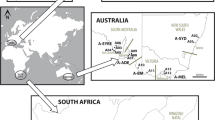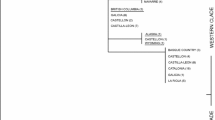Abstract
The Ring-necked parakeet (Psittacula krameri), native of Asia and Africa, is a very successful invasive species in Europe: it has been present there for over 50 years. A recent study showed that European invasive populations occupy a colder climatic niche than in their native range but the establishment of this tropical species in temperate regions remains unexplained. Two main hypotheses may explain the success of Ring-necked parakeet in Europe: admixture between individuals from different origins and/or rapid adaptation to new environmental conditions. In this study, we investigated with molecular data the origin of European populations of Ring-necked parakeets to assess whether these populations result from admixture between individuals from different source populations. We also investigated the morphology of individuals from European populations and from the native range to assess whether the invasive populations have morphologically diverged from their source and could have become adapted to European conditions. We found evidence of admixture in some of the European populations but not all of them. Admixture between individuals from different origins within European populations thus cannot explain alone their invasive success. Conversely, we found that the morphology of the individuals from European populations has diverged from the morphology of native individuals, in a similar direction. Rapid adaptation to European environmental conditions via phenotypic plasticity or natural selection could thus be a factor explaining the invasive success of Ring-necked parakeets in Europe.



Similar content being viewed by others
References
Adachi T, Ishikawa A, Mori S et al (2012) Shifts in morphology and diet of non-native sticklebacks introduced into Japanese crater lakes. Ecol Evol 2:1083–1098
Adams DC, Rohlf FJ, Slice DE (2004) Geometric morphometrics: ten years of progress following the “revolution”. Ital J Zool 71:5–16
Akaike H (1974) A new look at the statistical model identification. IEEE Trans Automat Contr 19:716–723
Amiot C, Lorvelec O, Mandon-Dalger I et al (2007) Rapid morphological divergence of introduced Red-whiskered Bulbuls Pycnonotus jocosus in contrasting environments. Ibis 149:482–489
Baylac M (2012) Rmorph: A “R” geometric multivariate morphometrics library; baylac@mnhn.fr. Institut de Systématique, Evolution et Biodiversité, Muséum National d’Histoire Naturelle, Paris, France
Boag PT, Grant PR (1981) Intense natural selection in a population of Darwin’s finches (Geospizinae) in the Galapagos. Science 214:82–85
Braun M (2009) Die Bestandssituation des Halsbandsittichs Psittacula krameri in der Rhein-Neckar-Region (Baden-Württemberg, Rheinland-Pfalz, Hessen), 1962–2008, im Kontext der gesamteuropäischen Verbreitung. Vogelwelt 130:77–89
Butler CJ (2003) Population biology of the introduced Rose-ringed Parakeet Psittacula krameri in the UK. PhD Thesis, University of Oxford
Cabezas S, Carrete M, Tella JL et al (2013) Differences in acute stress responses between wild-caught and captive-bred birds: a physiological mechanism contributing to current avian invasions? Biol Invasions 15:521–527
Carrete M, Tella J (2008) Wild-bird trade and exotic invasions: a new link of conservation concern? Front Ecol Environ 6:207–211
Chapuis M-P, Estoup A (2007) Microsatellite null alleles and estimation of population differentiation. Mol Biol Evol 24:621–631
CITES (2015) The CITES trade database. http://trade.cites.org/. Accessed 21 April 2015
Clergeau P, Vergnes A (2011) Bird feeders may sustain feral Rose-ringed parakeets Psittacula krameri in temperate Europe. Wildl Biol 17:248–252
Conant S (1988) Geographic variation in the Laysan Finch (Telespyza cantans). Evol Ecol 2:270–282
Curran JM (2006) R Package “Hotelling”. University of Auckland, New Zealand
Da Silva AG, Eberhard JR, Wright TF et al (2010) Genetic evidence for high propagule pressure and long-distance dispersal in monk parakeet (Myiopsitta monachus) invasive populations. Mol Ecol 19:3336–3350
Del Hoyo J, Elliott A, Sargatal J (eds) (1997) Handbook of the birds of the world (volume 4) sandgrouse to cuckoos. Lynx Edicions, Barcelona
Desrochers A (2010) Morphological response of songbirds to 100 years of landscape change in North America. Ecology 91:1577–1582
Dlugosch KM, Parker IM (2008) Founding events in species invasions: genetic variation, adaptive evolution, and the role of multiple introductions. Mol Ecol 17:431–449
Edelaar P, Roques S, Hobson EA et al (2015) Shared genetic diversity across the global invasive range of the monk parakeet suggests a common restricted geographic origin and the possibility of convergent selection. Mol Ecol 24:2164–2176
Evanno G, Regnaut S, Goudet J (2005) Detecting the number of clusters of individuals using the software STRUCTURE: a simulation study. Mol Ecol 14:2611–2620
Excoffier L, Lischer HEL (2010) Arlequin suite ver 3.5: a new series of programs to perform population genetics analyses under Linux and Windows. Mol Ecol Resour 10:564–567
Facon B, Pointier J-P, Jarne P et al (2008) High genetic variance in life-history strategies within invasive populations by way of multiple introductions. Curr Biol 18:363–367
Falush D, Stephens M, Pritchard JK (2003) Inference of population structure using multilocus genotype data: linked loci and correlated allele frequencies. Genetics 164:1567–1587
Forshaw JM (1989) Parrots of the World. Landsdowe, Willoughby
Griffiths R, Double M, Orr K, Dawson R (1998) A DNA test to sex most birds. Mol Ecol 7:1071–1075
Groombridge JJ, Jones CG, Nichols RA et al (2004) Molecular phylogeny and morphological change in the Psittacula parakeets. Mol Phylogenet Evol 31:96–108
Gunz P, Mitteroecker P (2013) Semilandmarks: a method for quantifying curves and surfaces, Hystrix. Ital J Mammal. doi:10.4404/hystrix-24.1-6292
Herrel A, Podos J, Huber SK, Hendry AP (2005) Evolution of bite force in Darwin’s finches: a key role for head width. J Evol Biol 18:669–675
Huelsenbeck JP, Ronquist F (2001) MRBAYES: Bayesian inference of phylogenetic trees. Bioinformatics 17:754–755
Jackson H, Strubbe D, Tollington S et al (2015) Ancestral origins and invasion pathways in a globally invasive bird correlate with climate and influences from bird trade. Mol Ecol 24:4269–4285
Jakobsson M, Rosenberg NA (2007) CLUMPP: a cluster matching and permutation program for dealing with label switching and multimodality in analysis of population structure. Bioinformatics 23:1801–1806
Kerr KCR (2011) Searching for evidence of selection in avian DNA barcodes. Mol Ecol Resour 11:1045–1055
Kolbe JJ, Larson A, Losos JB, de Queiroz K (2008) Admixture determines genetic diversity and population differentiation in the biological invasion of a lizard species. Biol Lett 4:434–437
Kooyers NJ, Olsen KM (2012) Rapid evolution of an adaptive cyanogenesis cline in introduced North American white clover (Trifolium repens L.). Mol Ecol 21:2455–2468
Kristjánsson BK, Skúlason S, Noakes DLG (2002) Rapid divergence in a recently isolated population of threespine stickleback (Gasterosteus aculeatus L.). Evol Ecol Res 4:659–672
Kristjánsson BK, Skúlason S, Noakes DLG (2004) Unusual number of pectoral fin rays in an Icelandic population of threespine stickleback (Gasterosteus aculeatus) recently isolated in freshwater. Evol Ecol 18:379–384
Lee CE (2002) Evolutionary genetics of invasive species. Trends Ecol Evol 5347:9–11
Lee CE, Gelembiuk GW (2008) Evolutionary origins of invasive populations. Evol Appl 1:427–448
Leisler B, Winkler H (1985) Ecomorphology. Curr Ornithol 2:155–186
Losos JB, Warheit KI, Schoener TW (1997) Adaptive differentiation following experimental island colonization in Anolis lizards. Nature 387:70–73
Morgan DHW (1993) Feral Rose-ringed parakeets in Britain. Br Birds 86:561–564
Mosimann J, James F (1979) New statistical methods for allometry with application to Florida red-winged blackbirds. Evolution 33:444–459
Nylander JAA (2004) MrModeltest v2. Program distributed by the author. Evolutionary Biology Centre, Uppsala University, Uppsala
Nylander JAA, Wilgenbusch JC, Warren DL, Swofford DL (2008) AWTY (are we there yet?): a system for graphical exploration of MCMC convergence in Bayesian phylogenetics. Bioinformatics 24:581–583
O’Neill EM, Beard KH, Pfrender ME (2012) Cast adrift on an island: introduced populations experience an altered balance between selection and drift. Biol Lett 8:890–893
Paradis E, Claude J, Strimmer K (2004) APE: analyses of phylogenetics and evolution in R language. Bioinformatics 20:289–290
Parr M, Juniper T (2010) A guide of the Parrots of the world. Bloomsbury Publishing, London
Peakall R, Smouse PE (2012) GenAlEx 6.5: genetic analysis in excel. Population genetic software for teaching and research—an update. Bioinformatics 28:2537–2539
Phillips BL, Brown GP, Webb JK, Shine R (2006) Invasion and the evolution of speed in toads. Nature 439:803
Pithon JA, Dytham C (2001) Determination of the origin of British feral Rose-ringed Parakeets. Br Birds 94:74–79
Pritchard JK, Stephens M, Donnelly P (2000) Inference of population structure using multilocus genotype data. Genetics 155:945–959
R Core Team (2013) R: a language and environment for statistical computing. R Foundation for Statistical Computing, Vienna
Raisin C, Dawson DA, Greenwood AG et al (2009) Characterization of Mauritius parakeet (Psittacula eques) microsatellite loci and their cross-utility in other parrots (Psittacidae, Aves). Mol Ecol Resour 9:1231–1235
Reznick D, Shaw F, Rodd F, Shaw R (1997) Evaluation of the rate of evolution in natural populations of guppies (Poecilia reticulata). Science 275:1934–1937
Rohlf FJ (2010a) TPSDIG, version 2.16. SUNY: Department of Ecology and Evolution, Stony Brook
Rohlf FJ (2010b) TPSRELW, version 1.49. SUNY: Department of Ecology and Evolution, Stony Brook
Rohlf FJ, Slice D (1990) Extensions of the procrustes method for the optimal superimposition of landmarks. Syst Zool 39:40
Rollins LA, Richardson MF, Shine R (2015) A genetic perspective on rapid evolution in cane toads (Rhinella marina). Mol Ecol 24:2264–2276
Ronquist F, Huelsenbeck JP (2003) MrBayes 3: Bayesian phylogenetic inference under mixed models. Bioinformatics 19:1572–1574
Rousset F (2008) genepop’007: a complete re-implementation of the genepop software for Windows and Linux. Mol Ecol Resour 8:103–106
Runemark A, Hansson B (2010) Island biology and morphological divergence of the Skyros wall lizard Podarcis gaigeae: a combined role for local selection and genetic drift on color morph. BMC Evol Biol 10:269
Shwartz A, Strubbe D, Butler CJ et al (2009) The effect of enemy-release and climate conditions on invasive birds: a regional test using the rose-ringed parakeet (Psittacula krameri) as a case study. Divers Distrib 15:310–318
Spurgin LG, Illera JC, Jorgensen TH et al (2014) Genetic and phenotypic divergence in an island bird: isolation by distance, by colonization or by adaptation? Mol Ecol 23:1028–1039
Stamatakis A (2006) RAxML-VI-HPC: maximum likelihood-based phylogenetic analyses with thousands of taxa and mixed models. Bioinformatics 22:2688–2690
Stockwell CA, Weeks SC (1999) Translocations and rapid evolutionary responses in recently established populations of western mosquitofish (Gambusia affinis). Anim Conserv 2:103–110
Strubbe D, Matthysen E (2009) Establishment success of invasive ring-necked and monk parakeets in Europe. J Biogeogr 36:2264–2278
Strubbe D, Jackson H, Groombridge J, Matthysen E (2015) Invasion success of a global avian invader is explained by within-taxon niche structure and association with humans in the native range. Divers Distrib 21:675–685
Swofford DL (2003) PAUP*. Phylogenetic analysis using parsimony (*and other methods). Sinauer Associates, Sunderland
Thioulouse J, Chessel D, Dolédec S, Olivier JM (1997) ADE-4: a multivariate analysis and graphical display software. Stat Comput 7:75–83
Verhoeven KJF, Macel M, Wolfe LM, Biere A (2011) Population admixture, biological invasions and the balance between local adaptation and inbreeding depression. Proc R Soc B Biol Sci 278:2–8
Yonekura R, Kawamura K, Uchii K (2007) A peculiar relationship between genetic diversity and adaptability in invasive exotic species: bluegill sunfish as a model species. Ecol Res 22:911–919
Zelditch ML, Swiderski DL, Sheets HD (2012) Geometric morphometrics for biologists: a primer. Academic Press, New York
Acknowledgments
We thank the LabEx BcDiv which financed our genetic analyses, the Observatoire de la Biodiversité Urbaine (Département Seine-Saint-Denis) and the Conseil Général du Département des Hauts-de-Seine which financed the captures of Ring-necked parakeets, the British Natural History Museum and the Muséum National d’Histoire Naturelle for giving us access to their collection of Ring-necked parakeets, the Muséum National d’Histoire Naturelle, the Naturhistoriska Riksmuseet, and Professor Michael Wink (Institute of Pharmacy and Molecular Biotechnology, Heidelberg University) for the samples they lent us. Finally, we thank the molecular systematic platform (SSM) of the Muséum National d’Histoire Naturelle, its staff, and particularly Josie Lambourdière. This study contributes to the reflections conducted by the European network on invasive parakeets: Parrotnet.
Author information
Authors and Affiliations
Corresponding author
Electronic supplementary material
Below is the link to the electronic supplementary material.
Rights and permissions
About this article
Cite this article
Le Gros, A., Samadi, S., Zuccon, D. et al. Rapid morphological changes, admixture and invasive success in populations of Ring-necked parakeets (Psittacula krameri) established in Europe. Biol Invasions 18, 1581–1598 (2016). https://doi.org/10.1007/s10530-016-1103-8
Received:
Accepted:
Published:
Issue Date:
DOI: https://doi.org/10.1007/s10530-016-1103-8




